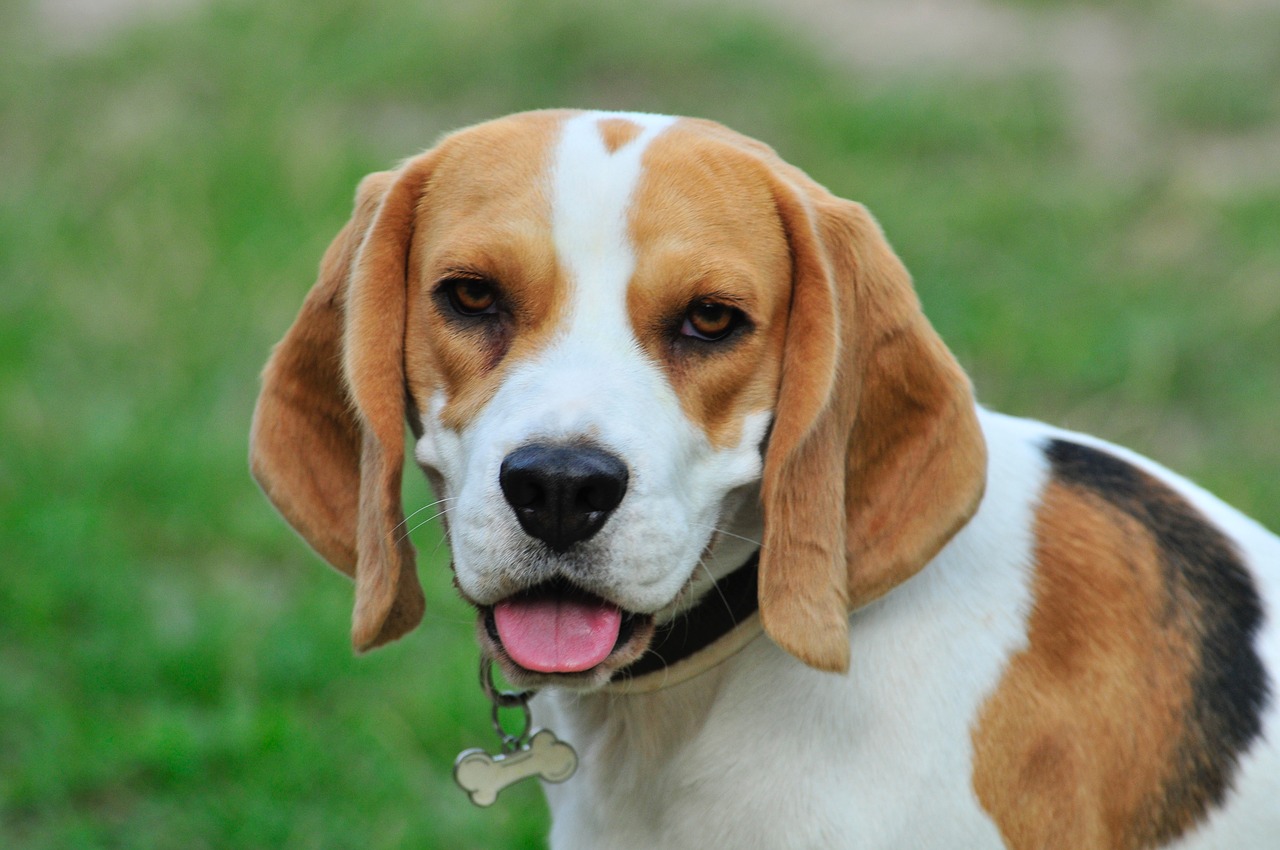Are Beagles hypoallergenic? Well…. unfortunately not! Beagles are classed as a moderate shedding dog breed. They produce both dander and saliva and can cause allergic reactions in a few people.
As beagles are a compact dog breed, with a short coat, they don’t shed as much as dogs with longer fur. Beagles will shed heavily during the spring months as their coat thins out ahead of the summer.
So let’s discuss the question ‘Are Beagles hypoallergenic?’
What Do Hypoallergenic Dogs Mean?
A hypoallergenic dog means he has very few or no allergy-producing substances known as allergens. These dogs don’t tend to cause an allergic reaction.
If a person has allergies, he might be looking for hypoallergenic breeds. Remember… No dog breed is 100% hypoallergenic.
The hypoallergenic dogs shed very little or no fur. Because of the least amount of shedding, the allergy-causing dander is released in a very small amount.
About Beagles
Beagles are one of the most popular and loved dog breeds around. They are compact dogs and have a signature look with soft facial features and classic floppy ears.
Beagles were bred as pack animals. They love to be around people and other animals. These dogs are extremely loyal to the family. They make great pets once their exercise needs have been met.
These dogs have a friendly, sweet, and affectionate personality. They are curious, charming, and intelligent but sometimes can also be mischievous. When bored or left alone for a longer duration of time, they can indulge in destructive behavior.
Beagles are easy to groom and are moderate shedders. They are not droolers and hence suitable for neatniks. You need to monitor their diet as Beagles are greedy eaters and have the potential to put on weight easily.
| Beagle Stats | Description |
| Dog Breed Group | Hound dogs |
| Purpose | Hunting dog and a loyal companion |
| Temperament | Friendly, Curious, Merry |
| Average Height | 13 to 15 inches tall at the shoulder |
| Weight Range | 18-30 lbs. |
| Energy level | Moderate |
| Exercise requirements | 20-40 minutes per day |
| Coat | Short coat with low grooming needs |
| Life Expectancy | 12 to 15 years |
Are Beagles Hypoallergenic?
Many people wonder if Beagles are hypoallergenic, but unfortunately, they’re not. While allergies vary from person to person, Beagles shed often and produce dander, which can trigger reactions. Despite their charm, their short coats contribute to allergens in the air. If you or someone you know has allergies, it’s wise to consider breeds with longer hair or non-shedding coats.
Do Beagles Shed a lot?
Shedding is a natural phenomenon and all dogs do so. This is due to their growth and regeneration of hair.
Beagles are moderate shedding dogs with a short and easy to maintain coat. They do shed, though not nearly as much as heavier coated dogs. Their shedding depends upon the weather, maintenance, diet, and few other factors. Beagles do lose some hair during seasonal changes like fall and spring, but overall they aren’t heavy shedders.
During shedding season, Beagles literally drop their undercoat in a matter of weeks.
Are Beagles okay for allergies?
Are Beagles high allergy dogs? Many people think that dogs are to blame for allergies, but in reality, it is proteins found in dog saliva and urine. The proteins stick to the dander, from your dog’s skin. As the fur is shed, the allergy-causing dander gets released into the air causing allergy symptoms. Beagles are an average shedding breed. But their allergens can be controlled with regular cleaning.
Why are Beagles not good pets?
Beagles are conveniently-sized, handsome and easy-to-groom dogs. They are friendly with people and peaceful with other pets. They are currently ranked 6th out of 195 breeds as far as popularity. Here are some reasons why beagles make excellent pets.

- Beagles are very sociable dogs as they are bred to live and work in packs.
- Beagles are friendly dogs and enjoy making new friends. This goes for humans and canines.
- Beagles tend to be healthy and low maintenance dogs. They don’t have long coats that require complicated or expensive trips to the groomer.
- Beagles are adaptable and can thrive in a variety of living conditions.
Beagles can be destructive when bored or not exercised enough. They’re not ideal pets if you don’t want to deal with these traits:

- Beagles can be loud and bark more than some other breeds.
- They have strong hunting instincts; they might not be the best dogs for homes with smaller pets.
- Beagles are incredible diggers; they might tear up your backyard.
- Beagles can be on the stubborn side. This may make training a challenge. Beagles are scent hounds and will follow their noses. This calls for consistent and persistent training based on respect.
Are Beagles hypoallergenic? At what age do Beagles start shedding?
Shedding is natural and all dogs experience a certain level of shedding. This is due to the essential growth and regeneration of hair in dogs.
Young Beagle puppies have a short and very soft coat. All Beagle puppies enter a phase of relatively fast transition where the puppy coat sheds off and is replaced by the elegant adult coat.
Beagles sheds the puppy coat at the age of 4-6 months. At this age, Beagles will get rid of the old puppy coat to develop the adult coat. So for a short period, fur may look very light and uneven. Generally, by the 12 to 15-month mark, the adult coat in Beagles should be fully grown in.

Common Signs that You Have Allergies to Dogs
Allergic reactions from Beagles can range from mild sneezing to much more severe symptoms. Some symptoms of dog allergies are:
Are Beagles hypoallergenic? How do I stop my Beagle from shedding?
If you are allergic to dogs, but still want to keep one, don’t worry! We are sharing some tips for families with allergies. Consider the following steps that you can take to manage your allergy symptoms.
- Regular brushing
Maintain a regular brushing routine for your Beagle. Brushing your dog regularly can help prevent an excessive amount of shedding because when you brush, oils on the coat spread and keep the coat healthy. You must ensure to do it outdoors to avoid excess hair in your home.
- Regular bath
Beagles don’t need to be bathed often, but having a bath once every one or two months is enough to remove dander from its coat. Regular bathing can minimize dander levels on your Beagle.
- Keep your bedroom pet-free
Keep your Beagle outside your bedroom where you spend a lot of time. Restrict him to only a few rooms of the house.
- Use vacuum in your house
Invest in an efficient vacuum. Use vacuum regularly and keep your floor and carpets clean.
- Consider an air purifier
Use an efficient air purifier and maintain good ventilation to help reduce airborne Beagle allergens.
- Keep your house clean
Dust and clean your home thoroughly and also your Beagle’s toys and bedding. Wash your Beagle’s rugs, beds, cushions, blankets, and washable play items and toys regularly to avoid dander build-up.
- Healthy diet
Providing your dog with healthy meals is not just good for his physical health, It can also improve his coat, which in turn limits shedding.

- Consider allergy shots
Allergy shots or allergy vaccines will help you develop antibodies so that you won’t get allergies when exposed to some allergens.
With a few efforts and lifestyle changes, you can manage your allergies and live happily with your Beagle.
What is the best dog for someone with allergies?
While no dog is 100% hypoallergenic, it’s possible to find less-allergenic dog breeds that are better suited for allergy sufferers. The AKC considers these breeds to be among the best dogs for allergy sufferers.
- Afghan Hound
- American Hairless Terrier
- Bedlington Terrier
- Bichon Frise
- Chinese Crested
- Coton de Tulear
- Giant Schnauzer
- Irish Water Spaniel
- Kerry Blue Terrier
- Lagotto Romagnolo
- Maltese
- Miniature Schnauzer
- Peruvian Inca Orchid
- Poodle
- Portuguese Water Dog
- Soft Coated Wheaten Terrier
- Spanish Water Dog
- Standard Schnauzer
- Xoloitzcuintli
Also read, are Corgis hypoallergenic?
How to Take Care of Beagle
Beagles are like small kids and heavily rely on our care as dog parents! Taking care of your Beagle involves a lot of things including feeding, grooming, training, and exercises.
Feeding your Beagle
A healthy and nutritious diet contributes to the overall health of your Beagle. These dogs need a nutritious and high-quality diet to stay healthy and full of energy.
Training your Beagle
Beagle is an intelligent breed but not easy to train. These dogs are strong-willed and can have an independent, stubborn streak. Here are some tips for Beagle training:
Grooming needs of Beagle
Beagles have a smooth and dense double coat. They are moderate shedders and easy to groom dogs.
Let’s get down to the grooming needs of Beagle:
You should have lots of treats ready for your Beagle during grooming sessions.
Exercise requirements of Beagle
Beagles are playful dogs and full of energy. They need a lot of opportunities to work it all off. By exercising your Beagle, you will prevent health problems and behavioral issues.
You can meet their exercise requirements through activities and games like:
Major Health Concerns of Beagle
Beagle is a moderately healthy breed with few health issues. The health conditions that may affect this breed are:
- Intervertebral Disk Disease (IDD): It occurs when the discs between vertebrae bulge and press on nerves.
- Hip Dysplasia: This is a degenerative condition and an inherited cause of hindlimb lameness in Beagles.
- Progressive Retinal Atrophy (PRA): It is a genetic disease characterized by the bilateral degeneration of the retina.
- Distichiasis: It occurs when an additional row of eyelashes grow in the Beagle’s eye and protrude along the edge of their eyelid.
- Epilepsy: A neurological disease in Beagles that causes seizures.
- Hypothyroidism: It is caused by a disorder of the thyroid gland.
- Beagle Dwarfism: This is a condition where the Beagle is smaller than normal.
- Chinese Beagle Syndrome (CBS): CBS is an autosomal recessive connective tissue disorder, characterized by a wide skull and slanted eyes.
- Patellar Luxation: It is the looseness of the kneecap that can result in dislocation.
FAQs: Are Beagles Hypoallergenic
Below are some questions commonly asked about ‘are beagles hypoallergenic dogs’ along with my expert answers to each question.
Beagles are not hypoallergenic dogs. They shed a fair amount and produce dander, which can trigger allergies in some people who are sensitive to pet dander. However, individual reactions to specific dog breeds can vary widely among allergy sufferers.
Yes, Beagles are sensitive dogs. They are affectionate and often bond closely with their owners. They can be sensitive to their owner’s emotions and may become anxious in stressful situations. Additionally, their keen sense of smell makes them sensitive to different scents in their environment.
If your Beagle is itching like crazy, it could be due to fleas, ticks, allergies, skin infections, dry skin, parasites, contact dermatitis, or underlying health conditions. Check for signs of fleas or ticks, examine their skin for redness or irritation, and consider any recent changes in their environment or diet. If the itching persists or is severe, consult your veterinarian for a proper diagnosis and treatment plan.
There is no dog breed that is 100% hypoallergenic. However, some breeds are considered more hypoallergenic than others due to their minimal shedding and low production of dander. These breeds include the Poodle, Bichon Frise, Maltese, Shih Tzu, Portuguese Water Dog, and several others.
Final Thoughts: Are Beagles hypoallergenic
So let’s summarize: are Beagles hypoallergenic?
So, Beagles are neither hypoallergenic nor high shedding dogs.
Beagles make great pets for families with children, due to their playful and loving nature. The charming appearance of these Hounds make them one of the most popular dog breeds in the world. If you are allergic and intolerant of dog hair in your house, then this breed is not for you.
Did you find this article useful? Feel free to share your thoughts. We would be happy to hear from you!
After reading all about are beagles hypoallergenic dogs, check are Goldendoodles hypoallergenic?


Comments are closed.